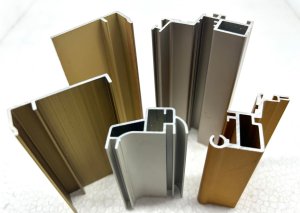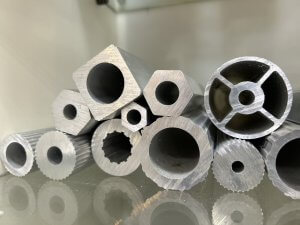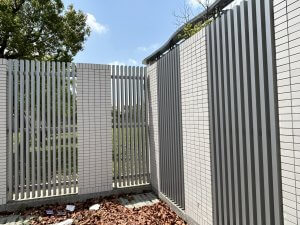【aluminum extrusion】 Surface Treatment Methods and Types
【aluminum extrusion】 Surface treatment is an essential technology for enhancing the performance and appearance of aluminum materials. By utilizing various treatment methods, aluminum can achieve increased corrosion resistance, improved wear resistance, and aesthetic appeal to meet diverse industrial needs. Primary surface treatment methods for 【aluminum extrusion】 include anodizing, electrophoretic coating, and sandblasting. These techniques not only extend the product’s lifespan but also enhance its market value. The following is a detailed explanation of these methods, their technical principles, types, and effects on aluminum performance.
Anodizing: High-Efficiency Corrosion Resistance and Hardness Improvement
Anodizing is one of the most commonly used surface treatments for 【aluminum extrusion】. This process uses electrolysis to form a dense protective layer of aluminum oxide on the aluminum surface, increasing its corrosion resistance, hardness, and wear resistance. Anodizing can be categorized into hard anodizing and standard anodizing based on the thickness and conditions of the oxide layer, each with unique effects in practical applications.
-
Hard Anodizing:
This process enhances the surface hardness of aluminum, making it suitable for products that require high wear resistance, such as mechanical parts and tools. The hardness of aluminum treated with hard anodizing can reach ceramic levels, capable of withstanding high-intensity friction and impact.
-
Standard Anodizing:
This more common anodizing method primarily improves the corrosion resistance and aesthetics of aluminum, ideal for building facades, consumer electronics, and other applications. This method also allows for various color options, enhancing decorative appeal.
-
Impact of Oxide Layer Thickness:
The thickness of the anodized layer typically ranges from a few to several tens of microns. A thicker layer results in increased corrosion resistance and hardness; however, processing costs and specific requirements must be balanced.
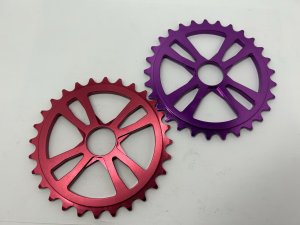
Electrophoretic Coating: Providing a Uniform Protective Layer and Enhanced UV Resistance
Electrophoretic coating is a technique where charged paint particles are uniformly attached to the aluminum surface under an electric field. This method forms an even coating covering every corner of the aluminum, enhancing its corrosion resistance and weather resistance. Electrophoretic coating is often applied to automotive parts, architectural aluminum profiles, and other products exposed to outdoor environments, with significant improvement in UV resistance.
-
Anodic Electrophoretic Coating:
This technique applies electrophoretic coating to anodized aluminum for multi-layer protection, significantly enhancing corrosion and wear resistance, making it suitable for outdoor-use aluminum profiles.
-
Cathodic Electrophoretic Coating:
Unlike anodic electrophoresis, cathodic electrophoretic coating allows more efficient paint adhesion and provides a thicker coating, resulting in stronger protection, ideal for high-durability products.
-
UV Resistance of the Coating:
The electrophoretic coating provides excellent UV resistance, effectively preventing discoloration and aging due to sunlight exposure, making it suitable for aluminum products in outdoor environments.
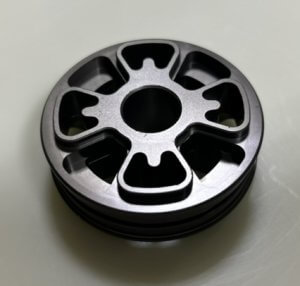
Sandblasting: Optimizing Aluminum Surface Texture and Preparing for Subsequent Treatments
Sandblasting is a mechanical treatment where high-speed sand particles impact the aluminum surface, removing oxide layers and impurities. This process not only smoothens the aluminum surface but also gives it a matte texture, preparing it for subsequent surface treatments. Sandblasting is widely used in industrial parts, the automotive industry, and high-end household products, making it an essential step for achieving high-quality surfaces.
-
Surface Cleaning and Roughening:
Sandblasting effectively removes oxides and impurities from the aluminum surface, providing an ideal foundation for subsequent anodizing or coating processes, ensuring the uniformity and adhesion of the treatment layer.
-
Texture Enhancement:
Sandblasting provides a matte or refined texture on the aluminum surface, suitable for products with special appearance requirements, such as consumer electronics and home decor items.
-
Enhancing Subsequent Treatment Effects:
Sandblasting increases the surface roughness of aluminum, aiding the adhesion of paint or anodized layers, further enhancing the material’s corrosion resistance and wear resistance.
【aluminum extrusion】surface treatment technologies are diverse and have unique characteristics, each method tailored to specific application scenarios and technical requirements. Anodizing emphasizes corrosion resistance and hardness improvement, electrophoretic coating features uniform coating and UV resistance, while sandblasting provides a foundation and texture optimization for surface treatments. In Taiwan’s 【aluminum extrusion】 industry, these surface treatment technologies have become vital tools for enhancing product competitiveness. As technology progresses, 【aluminum extrusion】 surface treatments will continue to play a crucial role in material protection and aesthetic enhancement, meeting the market’s diverse demands.
The application of 【aluminum extrusion】 surface treatments not only extends the service life of aluminum materials but also enables a wider range of design possibilities, making it indispensable in modern industry. For more information or inquiries, please contact 【Yuan-Cheng Aluminum Co., Ltd.】
contact us


